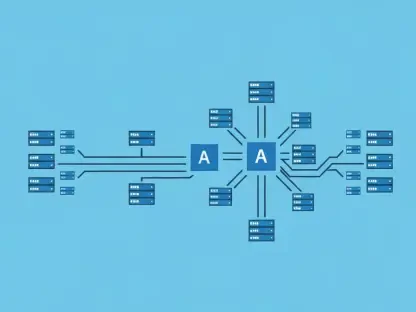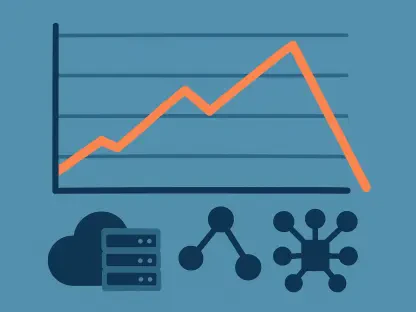As businesses across the globe grapple with the pressing need to optimize operations and reduce costs in an increasingly competitive landscape, Robotic Process Automation (RPA) emerges as a transformative solution that promises to redefine efficiency. This technology, which automates repetitive, rule-based tasks, is gaining traction as a cornerstone of digital transformation, allowing companies to streamline workflows and enhance productivity. With industries ranging from finance to healthcare adopting RPA at an unprecedented pace, the market is on the cusp of remarkable expansion over the next decade, from now through 2035. Driven by technological advancements and a growing demand for operational accuracy, this sector is becoming a focal point for stakeholders aiming to stay ahead of the curve. The insights into this dynamic industry reveal not only the potential for growth but also the challenges and opportunities that lie ahead for businesses ready to embrace automation.
Driving Forces Behind RPA Adoption
Technological Advancements Fueling Growth
The rapid evolution of technology stands as a primary catalyst propelling the RPA market forward, with innovations enhancing the capability of automation tools to integrate seamlessly with other digital solutions like artificial intelligence. These advancements enable RPA systems to handle increasingly complex tasks, moving beyond simple data entry to sophisticated decision-making processes that mimic human judgment. As companies recognize the value of such integrations, investment in RPA platforms surges, particularly in sectors where precision and speed are paramount. The ability to customize automation for specific business needs further accelerates adoption, as firms can tailor solutions to address unique operational bottlenecks. This trend of technological synergy is expected to continue shaping the market landscape through 2035, offering businesses a competitive edge by reducing human error and optimizing resource allocation in ways previously unimaginable.
Beyond the integration with cutting-edge technologies, the scalability of RPA solutions plays a crucial role in driving market growth, as organizations of varying sizes can implement automation without overhauling existing infrastructure. Small and medium-sized enterprises, in particular, benefit from cloud-based RPA platforms that lower upfront costs and provide flexibility to scale operations as needed. This democratization of access ensures that automation is no longer the preserve of large corporations with deep pockets but a viable option for diverse businesses aiming to boost efficiency. Additionally, the ongoing refinement of user interfaces makes RPA more accessible to non-technical staff, reducing the learning curve and fostering wider acceptance across departments. As these technological barriers diminish, the market is poised to witness a broader uptake, with adoption rates climbing steadily over the coming years.
Demand for Cost Reduction and Efficiency
A significant driver of RPA adoption lies in the unrelenting pressure on businesses to cut operational costs while maintaining high levels of efficiency, a challenge that automation addresses with remarkable effectiveness. By automating mundane tasks such as invoice processing or customer query handling, companies can reallocate human resources to more strategic roles, thereby enhancing overall productivity. This shift not only trims labor expenses but also minimizes errors that often accompany manual processes, saving firms from costly mistakes. Industries like finance and customer service, where repetitive tasks dominate workflows, are witnessing substantial benefits from RPA, as it enables faster turnaround times without compromising quality. The financial incentive to adopt such technology is clear, positioning RPA as a critical tool for cost-conscious organizations through the forecast period ending in 2035.
Moreover, the push for efficiency through RPA is amplified by the competitive nature of global markets, where businesses must operate at peak performance to retain their edge. Automation offers a pathway to achieve this by streamlining operations and enabling real-time data processing, which is vital for informed decision-making. For instance, in healthcare, RPA facilitates quicker patient data management, allowing providers to focus on care rather than administrative burdens. This efficiency gain translates into better service delivery and customer satisfaction, further incentivizing investment in automation solutions. As economic pressures mount, the ability of RPA to deliver measurable returns on investment becomes a compelling argument for its adoption, with market projections indicating sustained growth driven by these efficiency imperatives over the next decade.
Regional Dynamics and Competitive Landscape
North America and Europe Leading the Charge
In the realm of RPA adoption, North America and Europe stand out as mature markets, underpinned by robust technological infrastructure and a strong emphasis on innovation in business processes. The United States, Canada, and key European nations like Germany and the UK have embraced automation to enhance operational frameworks across various sectors, from banking to manufacturing. High levels of digital literacy and significant investments in research and development contribute to this leadership, enabling these regions to integrate RPA with existing systems efficiently. The presence of leading technology firms in these areas also fosters an environment of rapid deployment, as businesses leverage local expertise to implement automation strategies that align with their goals. This regional dominance is expected to persist, with steady growth projected through 2035 as more industries recognize the value of streamlined operations.
Additionally, regulatory support in North America and Europe plays a pivotal role in accelerating RPA adoption, as governments and industry bodies establish frameworks that encourage digital transformation. Incentives for adopting automation technologies, coupled with policies that address data security concerns, create a conducive environment for businesses to invest confidently. This is particularly evident in sectors with stringent compliance requirements, such as finance, where RPA ensures adherence to regulations while reducing manual oversight. Meanwhile, the cultural acceptance of technology-driven change in these regions further bolsters market expansion, as employees and management alike adapt to automation with relative ease. As a result, these areas continue to set benchmarks for RPA implementation, offering valuable lessons for other regions aiming to catch up in the automation race over the coming years.
Asia-Pacific as the Fastest-Growing Region
Turning to the Asia-Pacific region, a wave of rapid industrialization and digital initiatives positions it as the fastest-growing hub for RPA, with countries like China and India at the forefront of this surge. The sheer scale of economic activity in these nations, combined with a burgeoning need for operational efficiency, drives an aggressive push toward automation. Businesses here are increasingly adopting RPA to manage large volumes of transactions and data, particularly in manufacturing and IT services, where cost-effective solutions are critical. Government-led initiatives to promote digital economies further catalyze this growth, providing infrastructure and funding to support technology adoption. This dynamic environment suggests that Asia-Pacific will play a defining role in shaping global RPA trends through 2035, as its market share continues to expand at an impressive pace.
Equally important is the demographic advantage in Asia-Pacific, where a vast workforce necessitates efficient systems to handle administrative and operational demands, making RPA an ideal fit. The technology’s ability to process high volumes of repetitive tasks at low cost resonates strongly with businesses aiming to scale operations without proportional increases in labor expenses. Furthermore, the region’s growing tech-savvy population facilitates quicker adaptation to automation tools, reducing implementation hurdles that often slow progress elsewhere. As multinational corporations establish operations in this region to tap into cost advantages, they bring with them advanced RPA practices, further accelerating local adoption. This confluence of factors underscores Asia-Pacific’s potential to outpace other regions in market growth, setting the stage for transformative changes in business operations over the next decade.
Competitive Strategies of Key Players
The competitive landscape of the RPA market is shaped by major players who are navigating complex challenges through innovation and strategic partnerships, ensuring they remain at the forefront of industry advancements. Companies based in the United States and the UK, among others, are focusing on product development to enhance the functionality of their automation platforms, catering to diverse industry needs. These firms invest heavily in research to integrate RPA with emerging technologies, creating solutions that offer greater value to clients. Strategic alliances with other tech providers also play a critical role, enabling these players to expand their market reach and address specific sector demands. This competitive drive is expected to intensify through 2035, as businesses vie to capture a larger share of the burgeoning automation space with cutting-edge offerings.
Beyond innovation, these key players are also prioritizing customer education and support to overcome barriers such as workforce adaptation and implementation costs, ensuring smoother transitions to automated systems. Tailored training programs and robust after-sales services help clients maximize the benefits of RPA, fostering long-term loyalty in a crowded market. Additionally, a focus on cybersecurity within their offerings addresses growing concerns about data protection, a critical factor as businesses automate sensitive processes. By aligning their strategies with market needs, these companies not only strengthen their positions but also influence broader industry standards. Their proactive approaches in tackling both technological and human challenges highlight the evolving nature of competition in this space, paving the way for sustained growth and market leadership over the forecast period.









